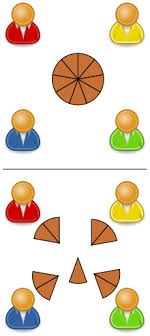|
|
| |
|
|
| |
|
|
|
|
| |
 |
| 20 / 4 = 5,
illustrated here with apples. This is said
verbally, "Twenty divided by four equals five." |
Division
Division is one of the four basic operations of
arithmetic, the ways that numbers are combined to make
new numbers. The other operations are addition,
subtraction, and multiplication. The division sign, a
symbol consisting of a short horizontal line with a dot
above and another dot below, is often used to indicate
mathematical division. This usage, though widespread in
anglophone countries, is neither universal nor
recommended: the ISO 80000-2 standard for mathematical
notation recommends only the solidus / or fraction bar
for division, or the colon for ratios; it says that this
symbol "should not be used" for division. |
|
Division by zero
Division of any number by zero in most mathematical
systems is undefined, because zero multiplied by any
finite number always results in a product of zero. Entry
of such an expression into most calculators produces an
error message. |
|
|
Examples |
 |
| The pie has 9
slices, so each of the 4 people receive 2 slices
and 1 is left over. |
|
 |
| 17 is divided into 3
groups of 5, with 2 as leftover. Here, the
dividend is 17, the divisor is 5, the quotient
is 3, and the remainder is 2 (which is strictly
smaller than the divisor 5), or more
symbolically, 17 = (5 × 3) + 2. |
|
|
|
|
|
|
|
|
|
|
|
|
|
|
|
|
|
|
|
Search Fun Easy English |
|
|
|
|
|
|
|
|
|
|
|
|
|
|
|
About
Contact
Copyright
Resources
Site Map |